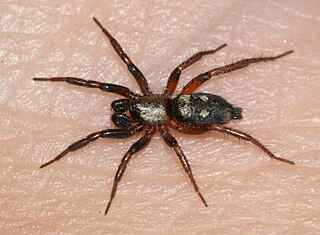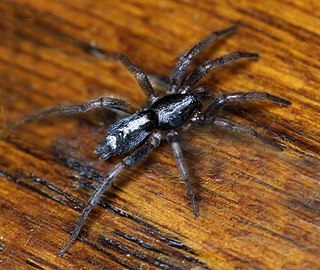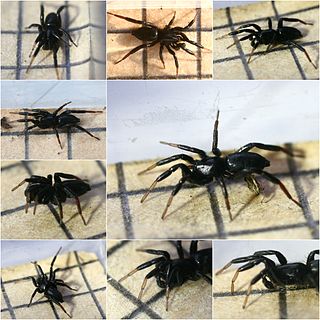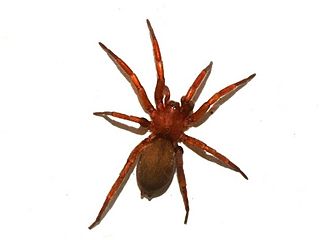
Ground spiders comprise Gnaphosidae, the seventh largest spider family with over 2,000 described species in over 100 genera distributed worldwide. There are 105 species known to central Europe, and common genera include Gnaphosa, Drassodes, Micaria, Cesonia, Zelotes and many others. They are closely related to Clubionidae. At present, no ground spiders are known to be seriously venomous to humans.

Prodidomidae is a family of spider, sometimes called long-spinneret ground spiders. It was formerly regarded as a subfamily of Gnaphosidae, but was raised to a family in 2022.

Drassodes is a genus of ground spiders that was first described by Niklas Westring in 1851. They are brown, gray, and red spiders that live under rocks or bark in mostly dry habitats, and are generally 3.8 to 11.6 millimetres long, but can reach up to 20 millimetres (0.79 in) in length.

Cesonia is a genus of ground spiders that was first described by Eugène Simon in 1893.

Callilepis is a genus of ground spiders first described by Niklas Westring in 1874. Some are found from Mexico to Canada, others from Europe to India. They are most commonly found in dry areas, sandy roads and beaches.

Zelotes is a genus of ground spiders that was first described by J. Gistel in 1848.

Gnaphosa is a genus of ground spiders that was first described by Pierre André Latreille in 1804. They all have a serrated keel on the retromargin of each chelicera.

Herpyllus is a genus of ground spiders first described by Nicholas Marcellus Hentz in 1832.

Micaria is a genus of ground spiders that was first described by Niklas Westring in 1851. They are 1.3 to 6.5 millimetres long.
Apodrassodes is a genus of ground spiders that was first described by J. Vellard in 1924.

Drassyllus is a genus of ground spiders that was first described by R. V. Chamberlin in 1922.
Eilica is a genus of ground spiders that was first described by Eugen von Keyserling in 1891.
Gertschosa is a genus of ground spiders that was first described by Norman I. Platnick & M. U. Shadab in 1981.

Haplodrassus is a genus of ground spiders that was first described by R. V. Chamberlin in 1922. They range from 3 to 10 millimetres. H. signifer is the most widespread species, found across North America except for Alaska and northern Canada.
Litopyllus is a genus of ground spiders that was first described by R. V. Chamberlin in 1922. As of May 2019 it contains only three species: L. cubanus, L. realisticus, and L. temporarius.
Nodocion is a genus of ground spiders that was first described by R. V. Chamberlin in 1922.
Synaphosus is a genus of ground spiders that was first described by Norman I. Platnick & M. U. Shadab in 1980.
Talanites is a genus of ground spiders that was first described by Eugène Simon in 1893.
Tivodrassus is a genus of Mexican long-spinneret ground spiders that was first described by Ralph Vary Chamberlin & Vaine Wilton Ivie in 1936. It was transferred to the ground spiders in 2018, but was returned to Prodidominae in 2022.










